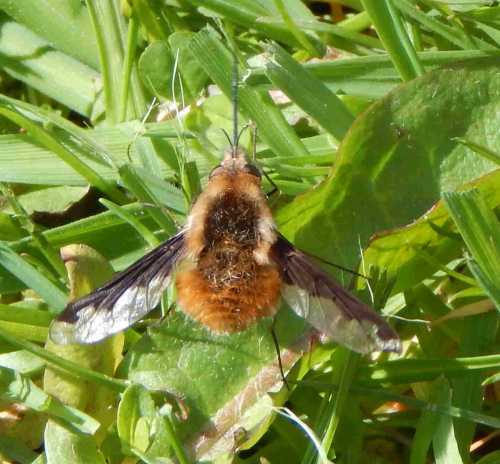How To Help Bumble Bees With Mites
Below is a photograph of a Bombus pratorum worker, foraging on a geranium flower, whilst festooned with phoretic mites called Parasitellus fucorum.
These mites are pretty common, and they spread between bumble bee colonies by attaching themselves to workers, and then dismounting into flowers visited by the bees.
They then wait for the next bumble bee visitor upon which to hitch another lift.
They are able to remain in a flower head for up to 24 hours, and it takes just 3 seconds for a mite to hop onto the bee's proboscis (tongue) or legs, and climb up onto the bee's body (Schwarz & Huck 19971).
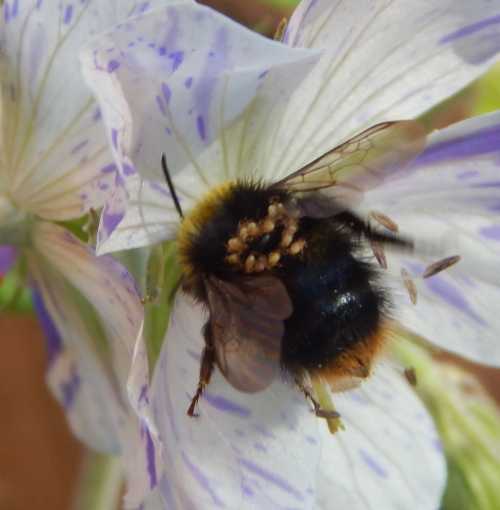 Bombus pratorum worker with a few phoretic mites attached to the thorax. Bees with a few mites like this should always be left alone.
Bombus pratorum worker with a few phoretic mites attached to the thorax. Bees with a few mites like this should always be left alone.Bumble Bees And Phoretic Mite -Parasitellus fucorum
In biology, the term 'phoresis', or 'phoresy', refers to a form of interaction where one species (the phoretic species) is transported by another (the host).
Although the mites are transported by workers, males and queens, it is proposed that they are able to distinguish between caste, and preferentially attach to queens2.
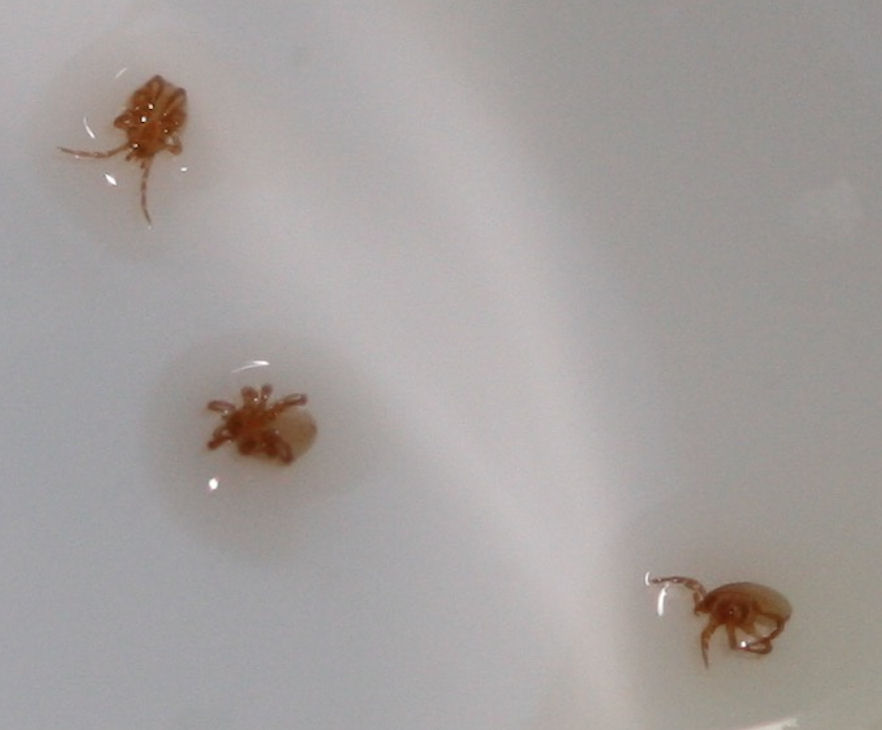 Phoretic mites Parasitellus fucorum - Photograph by Michaela Vardanis, with thanks
Phoretic mites Parasitellus fucorum - Photograph by Michaela Vardanis, with thanks
A bumble bee can continue to forage quite happily with a few mites on their bodies, but I have seen bumble bees, so infested that it appears they can hardly move.
Indeed, it has previously been proposed that "extremely high infestation can induce a negative effect on the host, decreasing its flight ability and capacity for food provisioning"3.
Furthermore, it has been stated that an infestation could potentially turn a merely commensal situation (the mite living alongside the bumble bee colony), into one that is more hazardous if the mites become vectors of disease (Haas et al 20194; Benton5).
Goulson6 also notes that an infested queen could be hampered in their ability to fly, feed, mate and hibernate.
In general, I find that mites on bumble bees provokes queries - i.e. how to help a bumble bee with mites.
But a few mites could be beneficial!
However, a recent study7 suggests these mites are primarily beneficial, and assist bumble bees, by making a contribution to nest and colony health. In particular, the study found that:
- Parasitellus fucorum is a helpful predator of harmful pests and parasites in bumble bee nests, including the eggs of the greater wax moth (Galleria mellonella) and bumble bee wax moth (Aphomia sociella) eggs and new larvae.
- A field trial showed that the presence of a Parasitellus fucorum population within bumble bee colonies leads to a 165% greater colony mass increase and a 119% higher number of workers on average compared with control colonies!
- Spring queens carrying Parasitellus fucorum were less likely to be infested by the parasitic nematode Sphaerularia bombi - you can read about this parasite on my page: Why Do Bumble Bees Dig?
Should you help a bee with mites, or not?
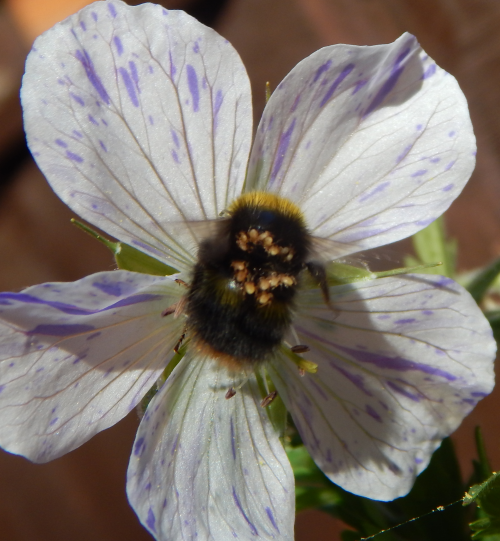 The same Bombus pratorum worker with phoretic mites having a slightly loosened grip.
The same Bombus pratorum worker with phoretic mites having a slightly loosened grip.
In the image above, the bumble bee has mites, but it is not covered in them, and is able to forage and go about its business. Busy bees with a few mites should always be left alone. It is thought that a few mites are unlikely to cause harm.
Should you attempt to help bumble bees infested with mites?
The Bumblebee Conservation Trust advocate leaving bumble bees with a few mites alone, but they also state:
"However, the mites may present a problem if an individual bumblebee becomes so heavily infested that it is unable to fly because of the weight of the mites. If this happens, you can try to remove some of the mites by gently brushing them with a child’s paintbrush."
As I write in 2021, I am increasingly uncertain about trying to interfere, even if it is tempting to do so, but in any event, usually there are not enough mites on the bee to warrant taking action, and trying to remove the mites may cause stress.
Please remember that bumble bees have survived for hundreds of years without humans interfering by picking off mites.
Also, note that bees do sometimes like to rest, and a resting bee is not necessarily about to die.
If a bumble bee is genuinely unable to move because it is heavily infested with mites, you may be able to gently flick some of the mites away using a soft brush. Anything sharp could damage or stress the bee, if only accidentally.
If in doubt, it may be better to leave the bee alone, and allow nature to take its course. You can help bees, by including bee-friendly plants in your garden.
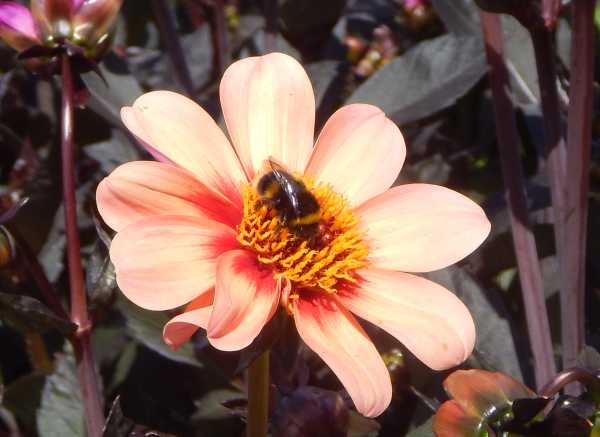
References
1. Schwarz, H., Huck, K. Phoretic mites use flowers to transfer between foraging bumblebees. Insectes soc. 44, 303–310 (1997). https://doi.org/10.1007/s000400050051
2. Kerstin Huck, et al. “Host Choice in the Phoretic Mite Parasitellus Fucorum (Mesostigmata: Parasitidae): Which Bumblebee Caste Is the Best?” Oecologia, vol. 115, no. 3, 1998, pp. 385–90, http://www.jstor.org/stable/4222022. Accessed 28 Apr. 2022.
3. Witaliński, W. and Jensen, J.-K. (2017) “The bumblebee mite Parasitellus fucorum (De Geer, 1778) (Acariformes: Parasitidae) : a new species for the Faroe Islands,” Entomologiske Meddelelser, 85(1-2), pp. 13–16.
4. Haas, S.M., Cardinal, S., Beaulieu, F. and Forrest, J.R.K. (2019), Mite‐y bees: bumble bees (Bombus spp., Hymenoptera: Apidae) host a relatively homogeneous mite (Acari) community, shaped by bee species identity but not by geographic proximity. Ecol Entomol, 44: 333-346. https://doi.org/10.1111/een.12706
5. Benton, T. Bumblebees - The Natural History & Identification of the Species Found in Britain. Collins 2006. Page 144.
6. Goulson, D. Bumblebees: Behaviour and Ecology. Oxford University Press. Page 63.
7. McArthur, R. (2020) Parasitellus fucorum: a beneficial mite for bumblebees. PhD thesis, University of Reading. doi: https://doi.org/10.48683/1926.00095009
If you found this page helpful or interesting, I'd really be grateful if you would share it with others - if not this page, perhaps another, such as Gardening For Bees.
Thank you so much :) .
